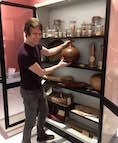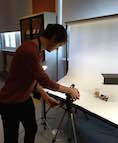The collection of useful plants
The biocultural collection (the collection of useful plants) consists of plant products and ethnographical objects made of plant material, mostly bought on market places in different parts of the world. Biocultural collections provide a unique link between botanical specimens and peoples use of plants for food, medicine, building material, clothes and ritual purposes.
The biocultural collections of the Natural History Museum of Denmark were established in 1906 and include about 2700 specimens. The collection also contains about 1,000 unregistered bottles with plant medicines from the old Vesterbro pharmacy, donated by S.E. Sanderman-Olsen.
The biocultural collection has been photographed and the information digitized in 2019 thanks to a donation from Apothecary Povl M. Assens Foundation. The images and data are available through www.GBIF.org
 Another important collection of useful plants is owned by NaturMedicinsk Museum, under the Department of Drug Design and Pharmacology at the Faculty of Health and Medical Sciences. NaturMedicinsk Museum has both a permanent exhibition and temporary thematic exhibitions open to all interested visitors.
Another important collection of useful plants is owned by NaturMedicinsk Museum, under the Department of Drug Design and Pharmacology at the Faculty of Health and Medical Sciences. NaturMedicinsk Museum has both a permanent exhibition and temporary thematic exhibitions open to all interested visitors.
The Botanical Market Place
Thanks to a donation from Povl M. Assens Foundation, the biocultural collections of the Natural History Museum of Denmark have been digitised in The Botanical Market Place, an open lab, where the public could engage with PhD student Sam Bruun-Lund, while he was sorting, registering and photographing the collections. The database and images are publicly available from GBIF.


